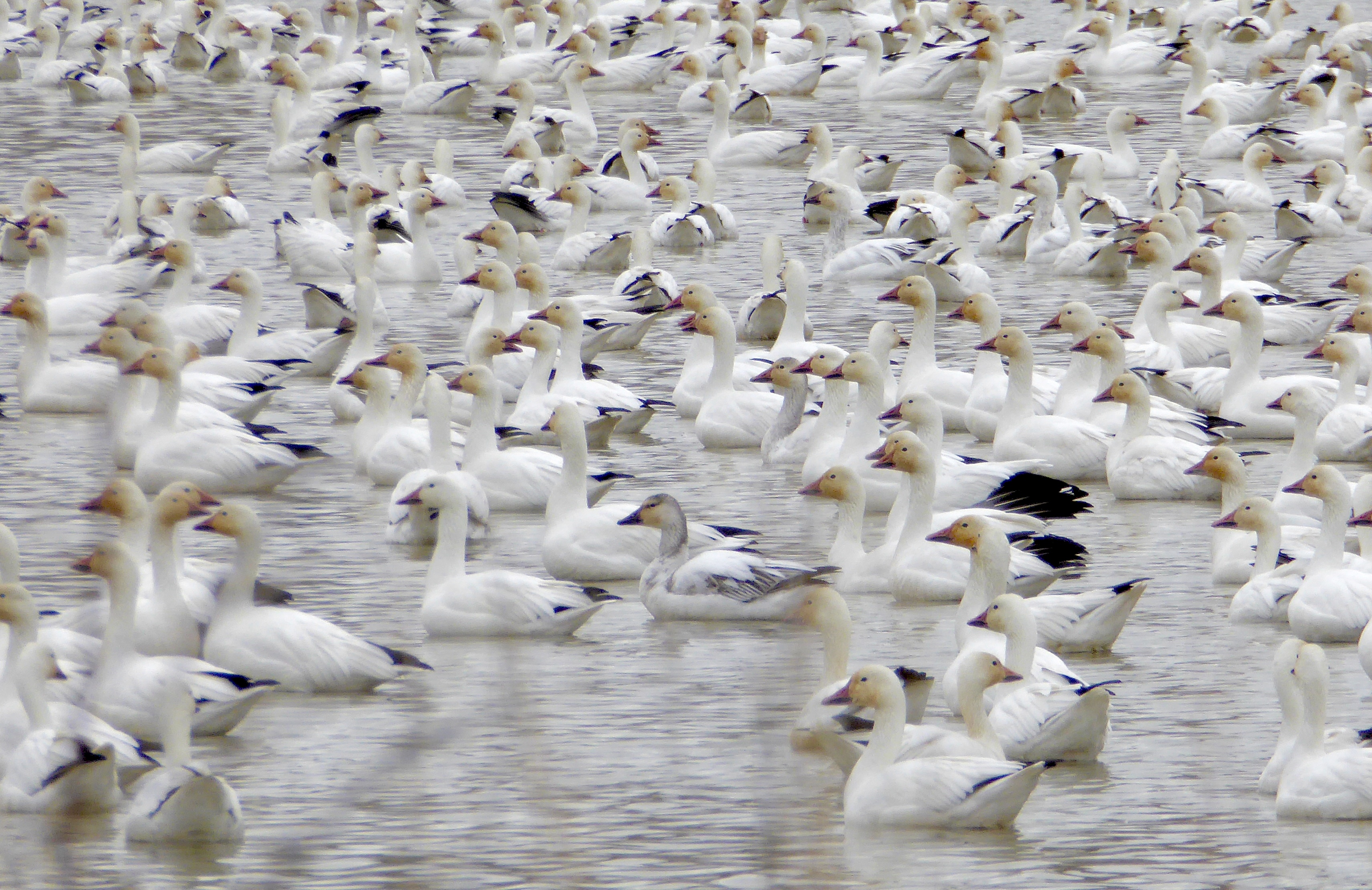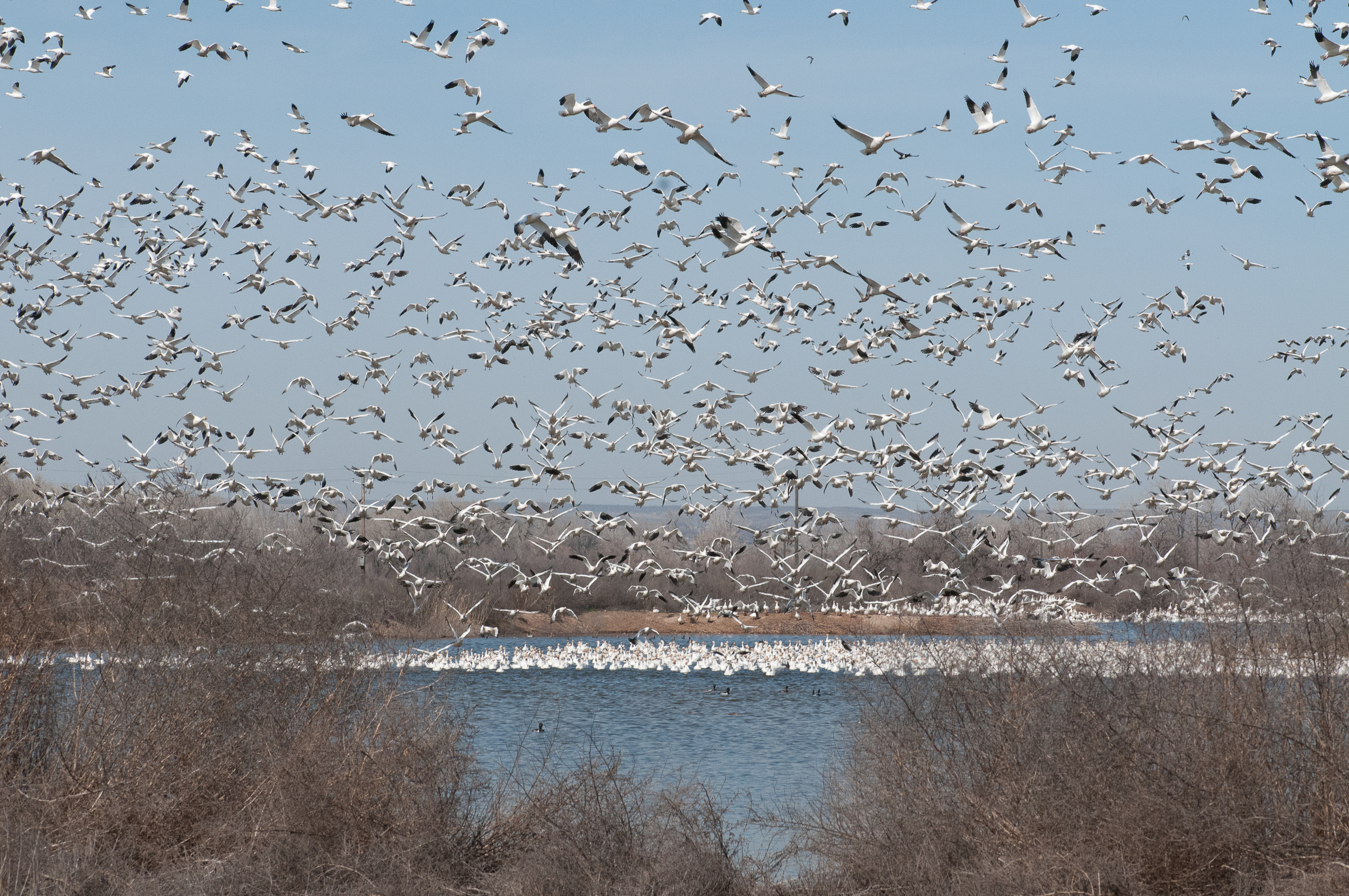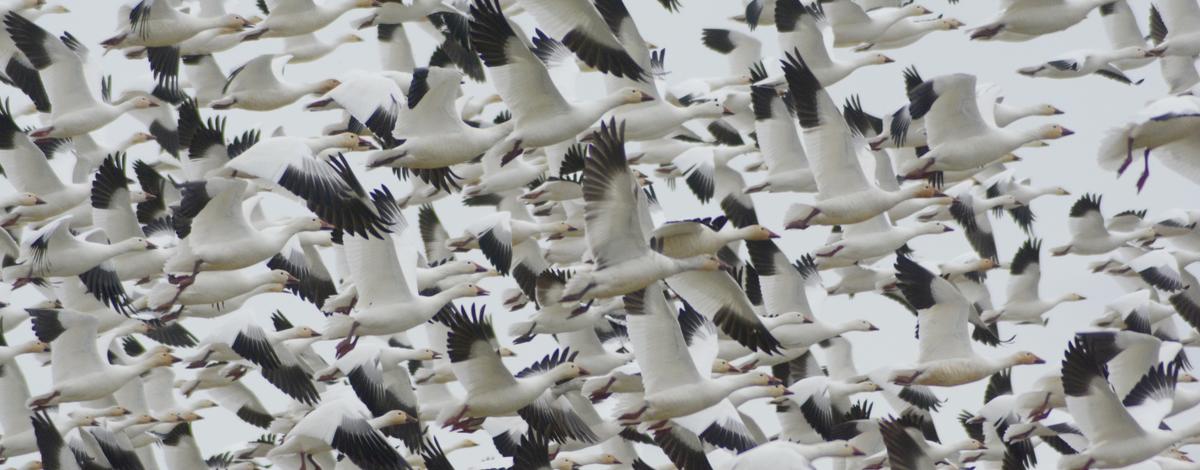Snow geese may be uncommon in Idaho in the fall and winter when many waterfowl hunters are hitting the fields, ponds and marshes, but in early spring, about 60,000 snow geese use Idaho as a stopover to feed and rest during their northern migration to their nesting grounds.
Snow geese migrate differently than most other waterfowl that pass through Idaho. The birds tend to take a “nonstop” flight through the state in the fall, resting only briefly, or not at all, so there’s little hunting opportunity.
But the birds tend to follow the weather on their reverse migration, settling in parts of southern Idaho in early spring until snow clears in the north and allows them to proceed toward their nesting grounds.

Snow geese’s unique migration allows a different hunting opportunity in Idaho. The spring “light goose” season, which includes blue, snow and Ross’ geese, is a relatively new opportunity for hunters. It started in 2010, unlike other waterfowl seasons that have existed for decades.
Since 2014, hunters in Idaho have also been allowed to use electronic calls and unplugged shotguns for hunting light geese when all other waterfowl and migratory game bird hunting seasons are closed. In addition to being a unique opportunity for hunters, the light goose season also helps reduce the damage the geese cause to grain and alfalfa crops that are just starting to spring up when they arrive here.
The 2019 spring snow goose season is only open in the Southwest and Magic Valley regions, and a portion of the Southeast Region. In that portion of Southeast Idaho, the season runs from Feb. 9 through March 10. In the Southwest and Magic Valley regions, the season runs from Feb. 18 through March 10.
For hunters interested in giving it a shot, here are 10 tips for spring season snow goose hunting:
Get a hunting party together
Buying all of the equipment needed to be a successful snow goose hunter can be expensive, and setting out dozens snow goose decoys can be labor intensive and time consuming. Getting a group together will help spread out the workload and the cost. Plus, it’s just more fun with friends.
Make sure everyone is properly licensed and knows the regulations
Both residents and nonresidents are required to have a 2019 Idaho migratory bird (HIP) permit and their 2018-19 federal duck stamp. Residents are required to have a valid 2019 Idaho hunting license. Nonresidents have a choice of several license types, depending on how many days and times they plan to hunt: a nonresident three-day small game license, a nonresident season small game license, or a nonresident hunting license/three-day fishing license.
All of those can be purchased at license vendors, at Fish and Game regional offices, or online at Fish and Game’s license page. If a hunter already purchased their 2018-19 federal duck stamp and attached it to their 2018 Idaho license (or out of state license), they should also bring that license on their hunting trip. The late season snow goose season is limited to certain portions of the state in Southern Idaho, and hunters should be aware of the boundary lines. More information and maps are available in the Migratory Game Bird 2018-19 Seasons and Rules.
Find the birds
This is crucial: If you want to have a successful snow goose hunt, you are going to need to track them down. Luckily, that shouldn’t be too hard: Snow geese fly and feed in large flocks.
Most people hunt snow geese over a large number of decoys in private, agricultural fields. Start by focusing your attention on fields near areas known to hold many snow geese, such as the Fort Boise WMA – which is closed to hunting during this time of year. Tens of thousands of snow geese stage on the ponds there, which is a primary roosting area during on their northward spring migration.

Ideally, the goal is to find a field where they have been feeding for a few days, and set up shop in the exact place you spotted them. Scout thoroughly before your hunt, and realize that the birds are going to bounce around.
Large flocks of snow geese can eat a field quickly – which is why you should line up as many landowners as possible before the season. While you are scouting, pay attention to how a flock of geese looks in the field, and what they sound like while feeding. That information will be valuable when it comes time to set out your decoys, or pick out a soundtrack for your electronic caller.
Asking for landowner permission
You are not going to have much luck finding snow geese on public land in Idaho – at least public land that is open to hunting – which means you will have to do some networking with landowners.
There is a right way and a wrong way to ask for permission to hunt private land. Common courtesy and respect go a long way. Here are some helpful tips for doing it the right way. If a landowner denies you permission to hunt the field where the geese are feeding, you might have better luck with another landowner nearby. Try to find an area that is in the flight path between where the geese are roosting and where they are feeding, and ask for permission to hunt there.
Public land hunting opportunities for snow geese are extremely limited. Snow goose hot spots in Southwest Idaho, including Fort Boise Wildlife Management Area, Payette River Wildlife Management Area and part of the Roswell Marsh Habitat area, are now closed to hunting and will remain so until the fall. Here is an explanation for why Fort Boise WMA and part of Roswell Marsh Habitat area are closed to hunting, and why it is actually good thing for snow goose hunting in Idaho.
Assemble your decoy spread
Because actual snow geese tend to congregate and feed in large flocks, large decoy spreads appear more realistic and are more effective in pulling them down from the sky. You should have somewhere in the neighborhood of a few hundred decoys, at minimum. ‘More is better’ is the prevailing philosophy when it comes to snow goose decoys.
If your group can spring for hundreds full-body decoys, that is great – but it might be unrealistic, especially if it is your first year chasing late season snows.
Windsocks and silhouettes are cheaper, are easier to move around in the field and transport to and from home, and each have their own benefits: Windsocks add movement to your spread (provided there is wind) and the silhouettes create the illusion of movement.
If you can add in a few dozen full body decoys to the windsocks and silhouettes, that is even better. Mix in some flyers and flags to add additional movement and realism.
If the price of decoys is a hurdle to your getting involved in snow goose hunting, you can save some money by making your own windsocks and silhouettes. There is a wealth of how-to information on the internet for decoy do-it-your-selfers.
Do not forgo the e-caller
The ability to use an electronic caller is the biggest advantage hunters have during this late season, and is worth the investment. With a little bit of knowledge and effort, you can build your own and save on cost. As with the decoys, blueprints are available online. There are also many snow goose sound files available for purchase on the web. Do some research and strive for realism.
Choosing gauge, shot size, and choke
It is best to leave the 20 gauge at home. While they might be smaller than Canada geese, these birds are still big and tough, and a 12 gauge is more appropriate. When it comes to choosing your shot size, #2, #1, #B, and #BB are some of the more popular options. Nontoxic shells are required. Match your choke to your ammunition, and be sure to pattern your shotgun at various distances before your hunt. If you put in the time to scout and you receive permission to hunt in what looks like a promising area, do not let that go to waste. You are going to want to know how and where your gun shoots. Here is a list of Fish and Game’s public shooting ranges.
Deploying your decoys
Do some research to identify some specific strategies, but do not forget about how the geese were dispersed in the field during your scouting. You should remember a couple of things. First, geese feed into the wind, which means your decoys should also be facing into the wind. Second, you want to leave an open space or landing zone for the geese within shooting range of where your group is stationed. Strive to create the shortest shots possible – the far edge of the landing zone should be no more than 40 yards away. The most realistic decoys should be the closest to the landing zone and the hunters. If something is not working, do not be afraid to change it up.
Concealment
Pull your waterfowl camouflage back out of the closet and pick up some face paint. Layout blinds are popular with snow goose hunters. If you have one, try to brush it up with cover from the general area you plan to hunt. If you do not, and are fine with lying on the ground, pick up a set of white, disposable coveralls and a can of matte black spray paint. Have a friend paint a few “x’s” on your suit to break up the white and mimic the crossed wing tips of a resting snow goose.
Know your target
The reason hunters can use electronic callers and unplugged shotguns during the spring snow goose hunt is because nothing else is in season during that timeframe. Blue, lesser snow, and Ross’s geese are the only birds you can harvest. White-fronted goose and Canada goose season is already closed. Be able to tell the difference between swans and snow geese. There is no open season for swans in Idaho.

